|
Linprop Newsletter
The first 3 months of 2014 were characterised by more buyers than sellers, stock shortages and quick sales. Two of our properties were sold within a week, one of them for full asking price.
The interest rate hike which came a bit earlier than predicted by economists, may have a bit of a negative impact on the market - it is too early to really tell. We still have lots of buyers enquiring and many visitors at show houses, although buyers seem to be a little more reluctant to make offers. That said, we had 3 offers on a renovated property which we had on show recently!
Transfer information for the last month of 2013 became available recently, and we have an article giving you a bit of an overview on the property market in 2013 in the areas we serve. There is a paperwork checklist for property owners who consider selling, information on termite infestation which can do a lot of damage to a property, and tips for the perfect outdoor entertainment area.
Last, but not the least, have a look at the special offer on granite tops we have negotiated for you!
Have a happy Easter holiday!
Kind regards
The Linprop Team
Daleen van der Linde 082 600 7894
Carina van der Linde 082 603 8694
Property prices in 2013
A picture - or graph - can speak a thousand words.
The graphs below reflect transfers in these areas between 1 January 2013 and 31 December 2013. The graphs show the percentage of transfers in each price bracket. The selling price of a property is influenced by its position, the condition, quality of finishes and the accommodation it offers.
There was a slight decrease in the number of full-title properties which changed ownership in the Linden area last year - 5.1% of the 1471 properties in Linden transfered in 2013, as opposed to 6.16% in 2012. The average price was slightly higher in 2013 - R1 913 000, as opposed to R1 831 000 in 2012. This represents an increase of 4.48%. One cannot buy a house in this area for less than a R1 000 000 - the properties which were sold in that price range, were stands.
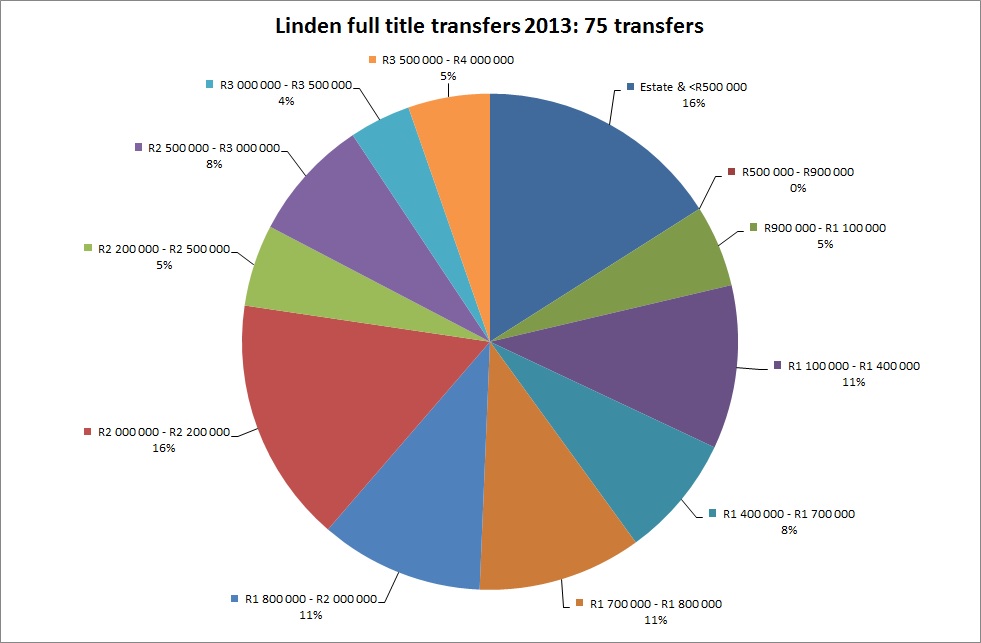
There are 694 sectional title units in Linden. 9.19% of sectional title units in the area changed ownership during 2013. Quite a large number -23% - was estate transfers. The majority of sectional title properties - 46% - sold for between R500 000 and R1 000 000. These were mostly flats. Townhouses sell for a million and more, depending on the size and the quality of the finishes.

In 2012 the average price in Darrenwood was R1 364 000. In 2013 the average price increased with 16% to R1 583 000, with 2 properties selling for more than R2 500 000 and 3 selling for less than R1 000 000. 9.2% of full title properties changed ownership in this area.
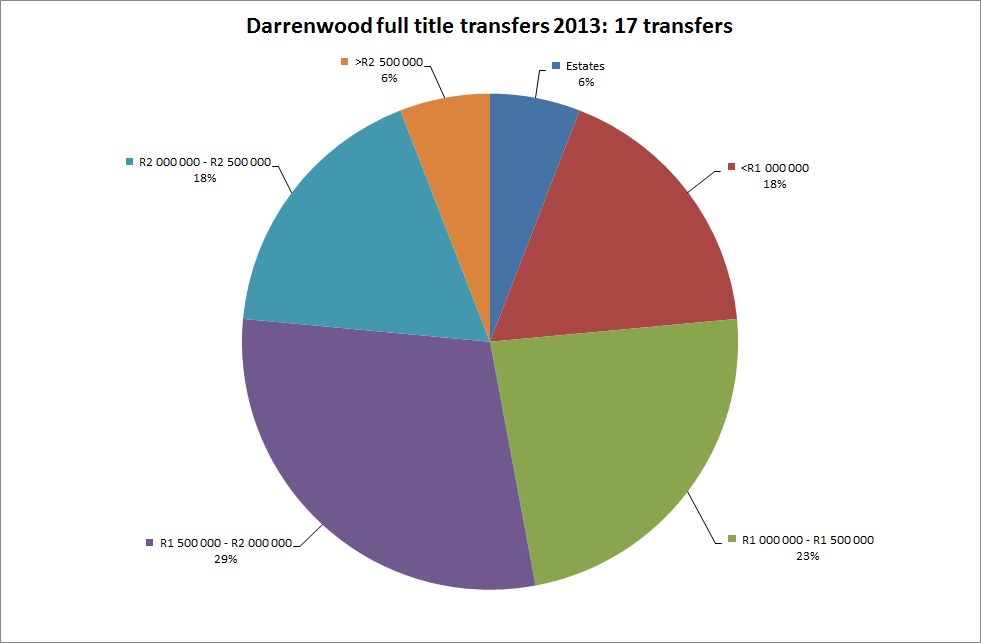
There are only 18 sectional title properties in this area, and 4 of them were transfered during 2013 - quite a high percentage of 22.2%
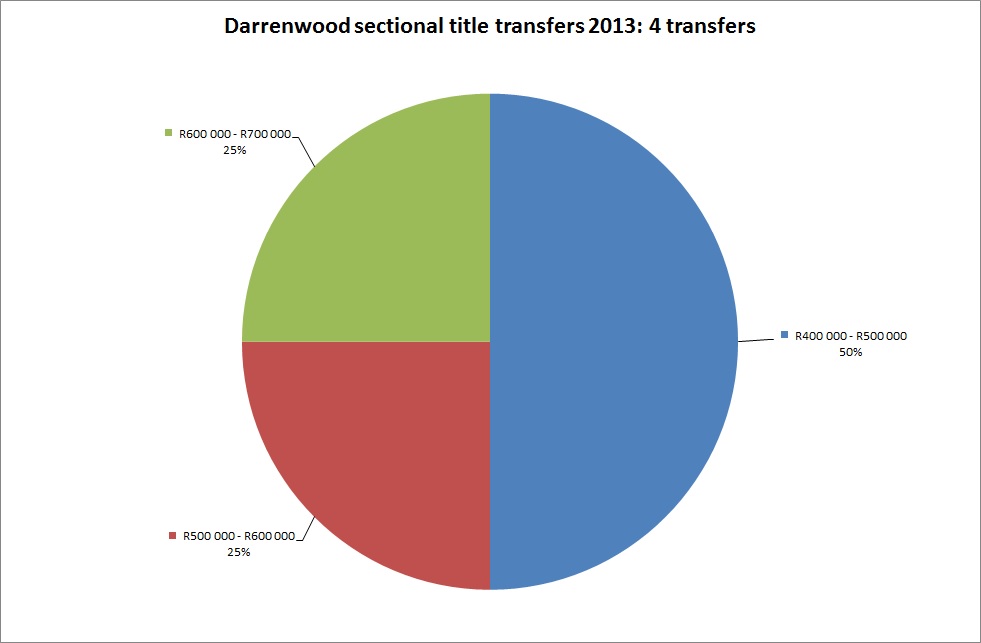
There are 804 full title properties in Roosevelt Park, of which 6.7% changed ownership during 2013. The average selling price was R1 564 000 in 2013, with only 2 properties (4%) selling for more than R2 500 000. In 2012 the average selling price in this area was R1 337 000. On a year to year basis the average price in this area increased with 4.7%.
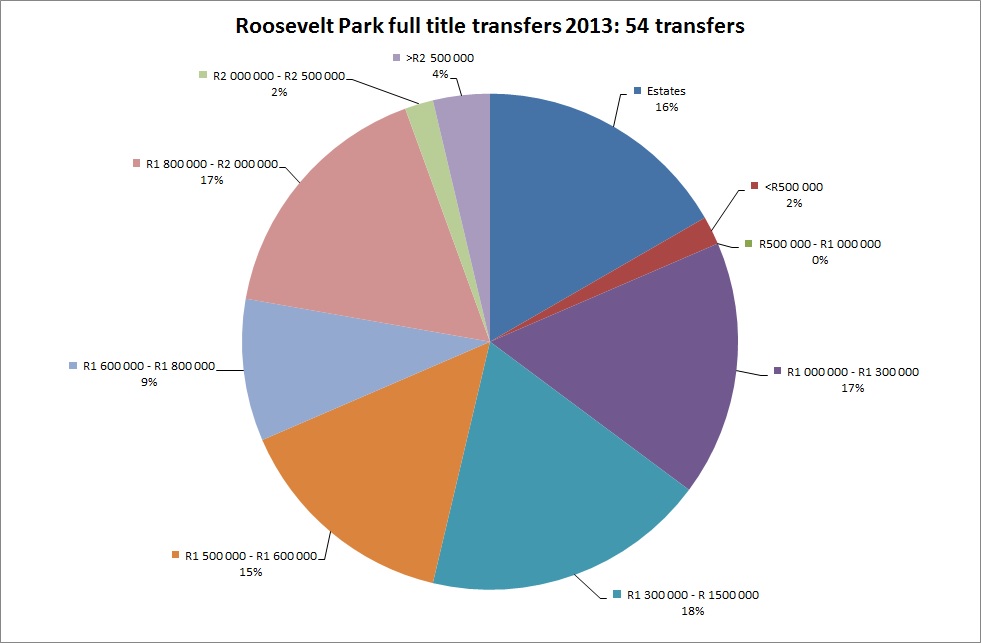
Only one sectional title unit was transferred in Roosevelt Park during 2013 - a unit in Rosepark Mews which was sold for R1 400 000.
There are 1007 full title properties in Melville, of which 88 were transfered to new owners in 2013 - that is 8.7% In 2012 the average price in this area was R1 400 000, and this increased with 8.9% in 2013 to R1 525 000. 10.7% of the 280 sectional title properties In Melville changed ownership in 2013.
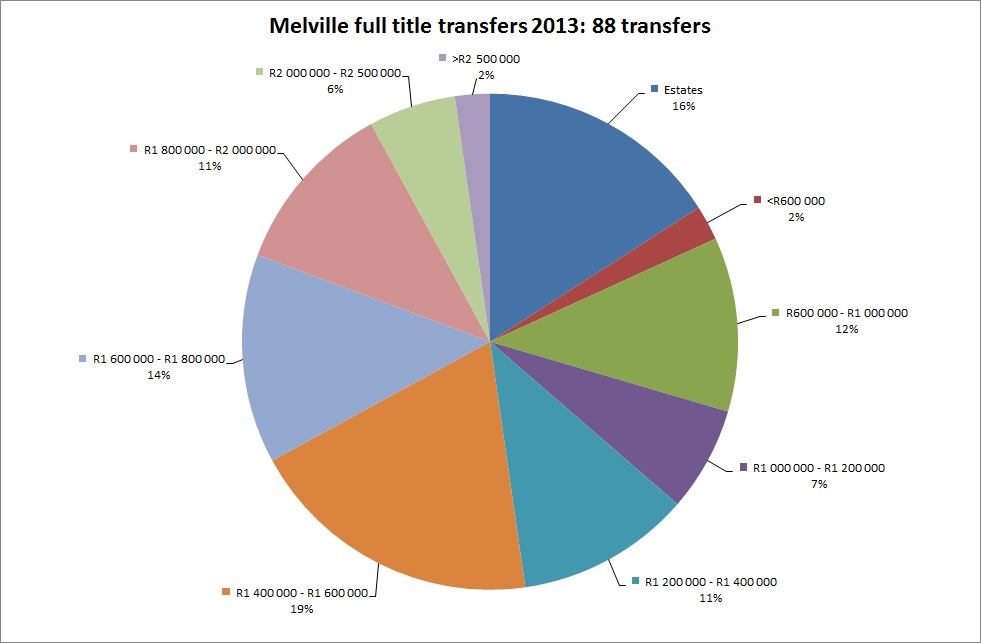
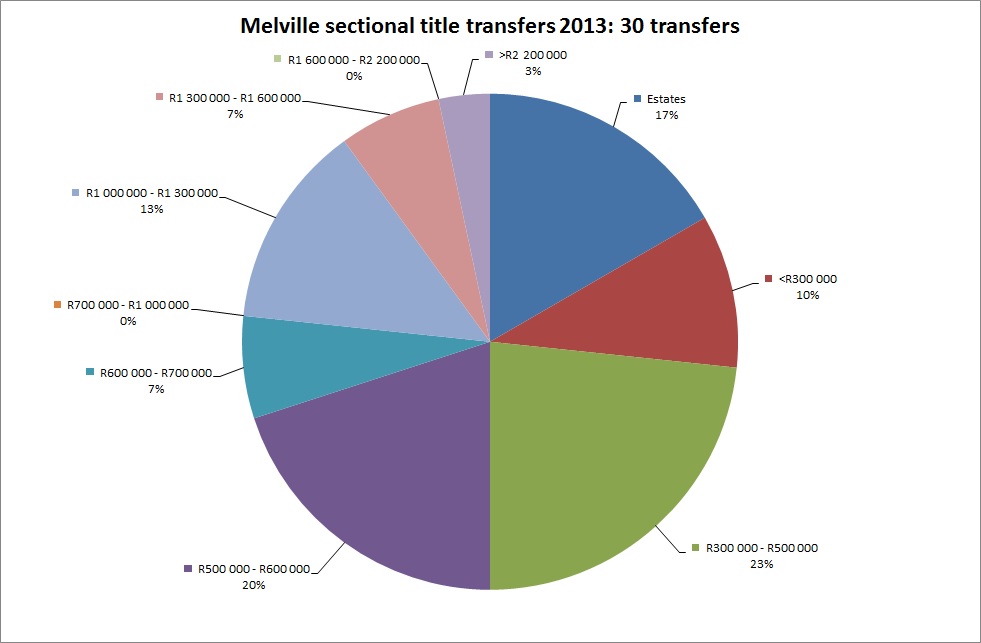
Although these graphs provide a broad picture of property prices in these areas, the best way to establish the probable market value of your property at any given time, is still to get a trustworthy estate agent to do a comparative market analysis for your specific property. Do contact us at any stage if you would like us to do this for you, free of charge.
Checklist before you sell your property
· If you have an existing bond over the property, give the bank 90 days notice of your intention to cancel the bond to avoid paying penalties.
· If the home is not bonded, make sure that you know the whereabouts of the original title deed. If it is lost, the conveyancer will have to apply for the issuing of a registered certified copy, which obviously takes time.
· Outstanding tax affairs will cause a delay when application is made for a transfer or VAT receipt. Ensure that your latest tax returns are filed and that all disputes are resolved.
· Rates and levy payments should be up to date. If you owe the body corporate or council a large amount, you will have to settle this debt before transfer, as a clearance certificate is required before transfer can be affected. It may be necessary to arrange bridging financing.
· If there is a dispute regarding outstanding levies or amounts due to the council, rather sort this out before putting your property on the market. When there is an unresolved dispute, the body corporate or Home Owners Association may refuse to issue the required clearance certificate.
· Be prepared for expenses associated with selling a property. As a seller, you not only have to pay all rates and levies in arrears, but also a pre-estimate of rates and levies, before the required clearance certificates will be issued. You will have to obtain a number of certificates of compliance – for electricity, electric fencing, and gas, and possibly a pest control certificate too. These entail an inspection and possibly work to meet the requirements for compliance. Budget for this, or even better, obtain the certificates before you put the house on the market.
· Buyers and/or banks often ask for copies of approved building plans as a condition of sale or before guarantees will be issued. Obtain copies from council if you do not have them on file. If you know that you have made alterations without having plans approved, rather address the matter now, and involve a professional to get the necessary approval.
· You may have had maintenance work done at the property which is still under guarantee, such as damp-proofing or roof repairs or a newly installed geyser. Make sure that you are in a position to make guarantees available to the buyer on request.
· It the property is registered in the name of a company, close corporation or trust, have a resolution, founding documents and Fica documentation ready. In the case of a trust, you also need a copy of the Letter of Authority.
· If you are married, have a copy of the marriage certificate and antenuptial contract ready. If you are divorced, have a copy of your divorce order and settlement agreement at hand.
· If the property is part of a deceased estate, the executor will need to comply with the terms of the will and the provisions of the Administration of Deceased Estates Act before the transaction can be concluded.
Termite is a scary word...
Termites are social insects, meaning that they live in colonies. When termites form a colony, or part of a colony is present in a structure, the structure is said to be infested. Because homeowners insurance typically does not cover termite damage, it is essential to detect termite infestation as soon as possible.
Be on the lookout for any of the following:
• Swarming termites, especially in spring when swarmers emerge from their nests and mate to begin new colonies. Winged termites can be distinguished from flying ants by their thick-waists, straight antennae and wings of equal size. Even if the actual swarming is not observed, the presence of discarded wings indicates that a colony is nearby. Broken-off wings are often found near doors or windows where the termites have been attracted to the light.
• Wood (floors, door and window frames, skirting boards, or even roof timber) that sounds hollow when tapped on. Termites feed on wood or other items that contain cellulose, such as paper, fibreboard, and some fabrics derived from cotton or plant fibres. Subterranean termites hollow out wood along the grain but the outer surface is usually left intact. You will find mud or soil underneath the very brittle exterior.
• Apparent water damage when water damage makes no sense. Termite damage can be similar in appearance and include swollen floors or ceilings, buckling windowsills, and bubbling paint or wallpaper.
• Termite droppings that look like sawdust. Faecal pellets are usually dry, smooth and powdery looking and can be many different colours. Unlike harvester termites, subterranean termites do not push wood particles or pellets (faecal material) to the outside, but rather use it in the construction of their tunnels.
• Mud tubes on exterior walls, generally the diameter of a pen. Although they nest in soil, subterranean termites can attack structures by building tubes that connect their nest to wood in structures. When opened up, you may see termites which have small, whitish translucent bodies. If you find no termites, it may be that they have abandoned that tube – it does not rule out infestation.
Some scary facts about termites are:
• The queen, the breeder of a colony, can live up to 18 years.
• A mature colony will have a number of nesting and feeding sites, all connected by tunnels through the wood.
• A single colony can have millions of termites and spread across a half an acre.
• Termites never sleep - they are always eating, 24 hours a day, 7 days a week ...
• Termite feeding can cause hundreds of thousands of rands of damage in a short period.
If you have any reason to suspect termite infestation, call in the experts to investigate, and have it professionally treated if any infestation is found. Treatment involves pesticides, skill and specialised equipment. This is one instance where a DIY job may be a very bad idea.
Outdoor entertainment areas
- A covered patio, preferably attached to the house, provides protection on sunny and rainy days. The roof can be a fixed structure, or one can opt for a less permanent cover like an awning or sun louvers. If this area has sliding or folding doors or blinds which can turn it into an outside room protected from cold, wind and rain, it is even better.
- The patio must be at least large enough for a table and chairs, but it is great if it is possible to create a comfortable seating nook, as well.
- The position of the patio is as important. A good entertainment flow is a selling point. This means that you want the patio to lead off the living rooms and/or kitchen. It should be possible to take guests to the patio without having to walk through the bedroom area. Proximity to the kitchen or a serving window from the kitchen to the patio, allows the hostess to be part of the party while busy with last minute preparations, and anything that may be needed at the braai is close at hand.
- If there is a pool, the patio should preferably overlook it, so that grown-ups can easily keep an eye on kids in the pool.
- No outdoor entertainment area is complete without a built-in braai or pizza oven, especially if you like to cook outdoors. The perfect built-in braai will cater for all preferred methods to braai such as open fire, briquettes and gas. Free-standing braai units are increasingly popular – plan for its position if this is your preference.
- A worktop next to the braai is very handy, as it provides space to put down dishes, tools and spices, and can also double as a server. This can be tiled, screed cement or a granite top - as long as it is durable and easy to clean. Having a small preparation area with a basin and tap can make life much easier, and if there is space for an outdoor fridge or wine cooler, guests won’t have to leave the entertainment area to refill their glasses. A storage facility for briquettes, wood or a gas cylinder is a good idea too.
- Comfortable patio furniture adds appeal. Various styles of furniture are available in wicker, wood, stainless steel, aluminium and even durable plastic. Cushions for comfort are a must.
- An open-fire pit next to the braai area creates additional entertainment space and atmosphere.
- Last, but not least, having a television screen available in the outdoor entertainment area will add the finishing touch for sports fanatics!
Granite tops at a special price, just for you!
<< News
|
|